We’ve been staying in the Dão valley of Portugal, which is not as well known as its neighbor to the north, the Douro valley. The Dão valley feels more centrally located, convenient to the university town of Coimbra, the coastal beaches of Aveiro, and centrally located between the capital of Lisbon and all of Northern Portugal. And while there’s plenty of winemaking in the Dão, the Douro valley is famous for Port wine. In fact, at least in Europe, if you buy a bottle labeled “Port”, the grapes were grown and the wine was made somewhere in the Douro valley. Even if you aren’t a fan of Port (we are huge fans), a visit to the Douro valley is worth it for the views. Our quinta‘s owners, Hugh and Jane, took us on a day tour as our visit wound down last week.

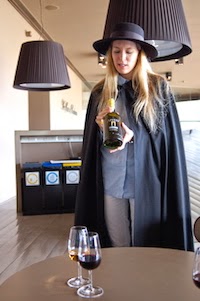
The drive up from Ponta de Gorda is an easy one on Portugal’s freeways. The drive will take you up and over the mountains (peaking at 950m), past huge lumbering windmills atop undulating hills, and back down into the Douro valley. On the way, we stopped and checked out a huge dam and lock, Hugh explaining how the lock worked to let boats pass up and down the river and making sure we could feel the hum of the turbines beneath our feet.
Proceeding up and along the river, we passed dozens of picturesque quintas and countless vineyards clinging to the hills overlooking the river. Our first stop, just short of the river town of Pinhão (PEEN-yow), was at the world-famous Sandeman winery, the home of Sandeman Port. The tour was fairly standard; we imagine it would be much more interesting during the fall harvest. As part of the fun and Sandeman mystique, our tour guide wore a black cape and wide brimmed hat all the way to the end of the tour and (our favorite part) the tasting. We were treated to a glass each of Porto Founder’s Reserve and Porto White. While the Ports were fantastic, the views from the porch outside their tasting room were even better.
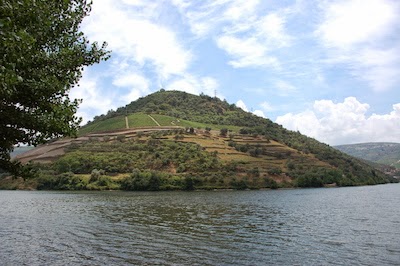 |
| Our View of the Douro River During Lunch in Pinhão |
From Sandeman’s we went into Pinhão and had lunch at a cafe by the river. It was the typical place we seek out for lunch when we’re traveling in Europe: a nice cafe with an outside space for alfresco dining, serving wonderful food at reasonable prices. Lori and I shared a caprese salad and a “Tosti”, a toasted (pressed) ham and cheese sandwich; Lori enjoyed a crisp, cool white wine, and (as I was driving) I enjoyed some aqua con gasse (bubbly water). From our lunch at Pinhão we were on to visit the winery of Noval.
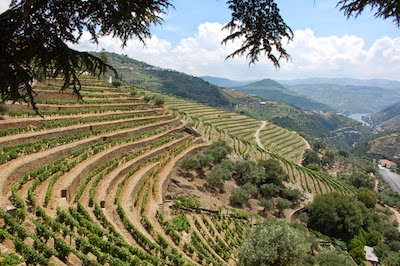 |
| Beautiful Terraces of Grapes at Noval Winery |
Another world-famous Port brand, what was so special about our visit to Noval was the grounds and the view. As we had seen throughout the Douro valley, Noval’s grapes were growing on terraces overlooking the valley. The terraces are formed with painstakingly built stone walls as old as 150 years old, and they make the most striking views. We found Noval to be a practically self-contained village, with wine making facilities next to living quarters for many of the workers.
From the Noval winery we proceeded through the Douro. As we went, Hugh pointed out too many interesting tidbits for me to remember now. There was the spot where the train went into the river, a winery that had recently expanded, how “sentinel trees” were used to mark the entrance to estates, and handfuls of beautiful abandoned quintas. We were headed to the village of Favaios, atop the mountains where the flat landscape was better suited for growing muscatel grapes. We proceeded straight to a hill overlooking the village where we found a tiny chapel Hugh called the “mother church” for the village. The mother church had been built first, but as the village prospered the large church down in the village was built. A benevolent statue of the Good Shepherd stands watch–arms spread–over the village of Favaios and the surrounding vineyards of muscatel.
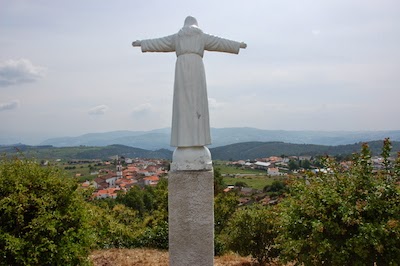 |
| Overlooking the Village of Favaios |
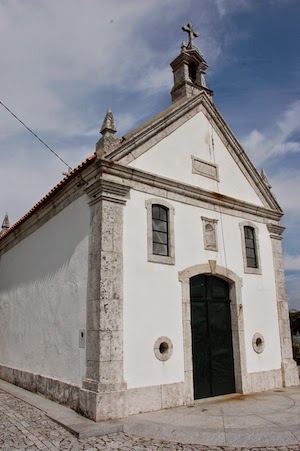 |
| The “Mother Church” of Favaios |
Passing back down through the village we stopped in for a visit at a nifty little museum detailing the traditional production of muscatel wine (much like Port) and bread. The €1.50 admission proved well worth it as it included a tasting of the village’s muscatel wine and offered spectacular panoramic views of the village and surrounding area.
From Favaios we turned home, stopping again at the train station in Penhão to see some beautiful blue tile art depicting the history of wine making and distribution for the Douro valley. The tile work would easily remind you of Dutch delftware pottery.
The Douro valley was a fascinating day trip from our home base in the Dão valley, and well worth the visit. One day we might even return and take a Douro river cruise, but we’re glad we stayed where we did this time.






